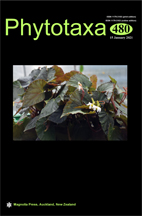Abstract
A new fern species, Selliguea wusugongii (Polypodiaceae), is described from southeastern Xizang, China. Morphologically, S. wusugongii is distinguished in the genus by having long need-like fronds with width of the lamina only 0.8–1.1 mm, and is the species with the narrowest laminae in selligueoid ferns. The new species is most similar to some Malay selligueoid ferns in morphology, S. bisulcata and S. subsparsa for example, by having simple fronds, narrow laminae and marginal rounded sori, but differs from them in having considerably more scattered scales, frond monomorphic and up to 40 cm long. A phylogenetic analysis based on five plastid markers supported the new species as most closely related to S. rhynchophylla. However, the two species are different from each other in quite a few morphological characteristics, such as the size of fronds and the visibility of venation, and the position of sori.

